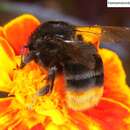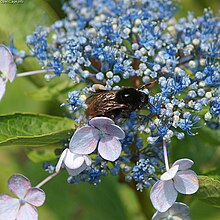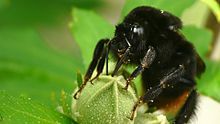mk
имиња во трошки


Bombus ignitus is a species of bumblebee in the family Apidae.[2] It is mainly distributed in Eastern Asia, commonly found in China, Japan and Korea. It is used in China and Japan commercially as a pollinator.[3] B. ignitus is a eusocial insect with a queen that is monandrous: mating with only one male in the late summer before hibernating until the following spring. It builds its nest out of a mass of pollen and lays its eggs after completion. Due to numerous conflicts between queens and fertile workers, some surviving queens are badly injured, described by some as living corpses.[4]

Bombus ignitus is part of the order Hymenoptera, which is the third largest order of insects. It is a member of the family Apidae, consisting of bees, and the subfamily Apinae, which contains the majority of species within Apidae. The subfamily Apinae consists of 14 tribes, including the tribe Bombini, which B. ignitus is a part of. Bombini contains a single living genus Bombus. B. ignitus can be further classified into the subgenus Bombus sensu stricto, or Bombus in the sense of the original author.[5]
The species name ignitus is a Latin adjective, meaning "containing fire."[6]

Bombus ignitus is a large bee characterized by a medium length tongue. Females have black bristles that cover the back of the thorax and the mid-legs. The abdomen is separated into five tergum. Starting from the thorax, the first three terga are black in color, whereas the fourth and fifth terga are orange-red in color. Males are characterized by golden yellow bristles that form two bands on the anterior and posterior thorax. Like the female, the male has an abdomen separated into five tergum. Starting from the thorax, the first two terga are golden yellow in color, differentiating males from females. The third tergum is black in color. The fourth and fifth terga, like the female, is orange-red in color. Compared to the female, the male compound eye is small. The antenna of males are shorter than the antenna of females, reaching only to the base of the wings. Compared to the males of other bumblebee species, the males of B. ignitus have greatly broadened penis valves that flare outwards to form a funnel shape. The queen has a body length of 19 mm. Workers have a body length of 15–17 mm. Males have a body length of 17 mm.[7]
Bombus ignitus is found in the Palearctic realm, primarily in East Asia.[7] This includes the more humid and temperate areas China, Japan, and Korea.[3] Populations of B. ignitus can be found at a mean altitude of 1425 m at the western, southern, and eastern foothills of the Sichuan Basin. Though uncommon, populations have been found at lower altitudes.[7]
Colonies of B. ignitus are short-lived, with new colonies founded each year. Young queens mate with drones in the later summer, then hibernate and emerge in the following spring. Upon emerging from hibernation, these queens search for a suitable nesting site to start a colony. After a suitable site is found, these queen begin to gather pollen. A queen builds a mass of pollen at the nesting site, then lays her first batch of diploid eggs.[8] Workers emerge from this first batch of eggs. These workers start to forage two to three days after emerging. With the emergence of workers, the queen is able to spend more time on oviposition. During the late summer, many new queens and new drones are produced. Only mated queens will hibernate through the fall and winter, then emerge in the spring.[9]
Bombus ignitus exhibits a size dependent division of labor. An aforaging gene, Bifor, has been isolated in B. ignitus. Bifor expression negatively correlated with size, with higher levels of expression found in the smaller nurses. Foragers are larger in size and have lower levels of Bifor expression.[10]
Bombus ignitus is monandrous; the queen mates with only a single drone to form a colony. All workers and new queens, as a result, are descendants of the queen and a single drone.[4] This monandrous behavior decreases the amount of genetic variation present in a single colony relative to that of a polygynous or polyandrous species.
Both the queen and workers possess the ability to reproduce. The queen suppresses the reproductive actions of workers through increased aggressive action against reproductively active workers and destruction of eggs laid by workers. In colonies still dominated by the queen, the vast majority of drones are derived from the queen. In colonies where the queen has died, roughly half the drones are born from workers.[4]
Bombus ignitus, like many bees, exhibit Haplodiploidy. Diploid queens produce diploid workers and new queens from fertilized eggs. Haploid drones are produced from unfertilized eggs, laid by either the queen or workers.[4] All sperm produced by a drone is identical, containing its exact haploid DNA. Variation arises from females, who produce genetically variant eggs through meiosis. Sex is determined under a single-locus complementary sex determination (sl-CSD) system, where multiple alleles at a single locus determine the sex of an individual. Sex locus heterozygotes develop as females, while hemizygous and homozygous eggs develop as haploid and diploid males.[11]
As the queens of B. ignitus mate with only one male, the workers are more closely related to other workers (with whom they share an average of seventy five percent of their genes with) than to the queen (who they only share half their genes with). With respect to male offspring, workers are more closely related to the sons of other workers, sharing an average of 37.5 percent of their genes with them, than the sons of the queen, who they only share 25% of their genes with.[4]
Worker policing, manifested through aggressive actions against fertile workers and removal of the eggs of workers, has been observed in colonies of B. ignitus. Similarly, reproductive workers have been observed taking aggressive behavior against founding queens. These include eating the eggs laid by the queen and laying eggs themselves, as well as attacking the queen herself. In an analysis of seven B. ignitus colonies, the survival rate of colony founding queens was 72%. These queens had damaged wings or bodies, which suggests numerous conflicts with workers.[4]
Bombus ignitus is currently used for agricultural pollination in China and Japan.[3] The species has been chosen as a reliable species for commercial mass-production in Korea, though issues of diapause management must still be addressed. B. ignitus was chosen over the already established bumblebee, Bombus terrestris, for fear of competition or genetic contamination by mating with native bumblebee species.[12]
The protein BiVSPI, Found in the venom of B. ignitus, has been identified as a serine protease inhibitor. BiVSPI exhibits antimicrobial functions, and has been found to inhibit the growth of Gram-positive bacteria and fungi.[13] The cDNA of four antibacterial peptide genes - apidaecin, hymenoptaecin, abaecin, and defensin - were isolated and cloned from B. ignitus.[14] Synthesized abaecin has been shown to inhibit the growth of Gram- negative bacteria, but had little inhibitory effect towards the growth of Gram-positive bacteria.[15]
Bombus ignitus is a species of bumblebee in the family Apidae. It is mainly distributed in Eastern Asia, commonly found in China, Japan and Korea. It is used in China and Japan commercially as a pollinator. B. ignitus is a eusocial insect with a queen that is monandrous: mating with only one male in the late summer before hibernating until the following spring. It builds its nest out of a mass of pollen and lays its eggs after completion. Due to numerous conflicts between queens and fertile workers, some surviving queens are badly injured, described by some as living corpses.
Bombus ignitus es una especie de abejorro, un himenóptero apócrito de la familia Apidae,[1] que se distribuye principalmente en el este de Asia. Se encuentra comúnmente en Corea, China y Japón. En estos dos últimos países se comercializa como polinizador.[2]
Bombus ignitus es una abeja grande caracterizada por una lengua de longitud media. Las hembras tienen cerdas negras que cubren la parte posterior del tórax y las piernas. El abdomen se separa en cinco tergas. A partir del tórax, las tres primeras tergas son de color negro, mientras que la cuarta y quinta son de color rojo anaranjado. Los machos se caracterizan por cerdas de color amarillo dorado que forman dos bandas en el tórax anterior y posterior. Al igual que la hembra, el macho tiene un abdomen separado en cinco tergas. A partir del tórax, las dos primeras tergas son de color amarillo dorado, diferenciando a los machos de las hembras. El tercer tergito es de color negro. La cuarta y quinta terga, como la hembra, es de color rojo anaranjado. En comparación con la hembra, el ojo compuesto masculino es pequeño. La antena de los machos es más corta que la antena de las hembras, llegando solo a la base de las alas. En comparación con los machos de otras especies de abejorros, los machos de B. ignitus han ampliado enormemente las válvulas del pene que se ensanchan hacia afuera para formar un embudo. La reina tiene una longitud corporal de 19 mm. Los trabajadores tienen una longitud corporal de 15–17 mm. Los machos tienen una longitud corporal de 17 mm.[3]
Bombus ignitus se encuentra en el paleártico, principalmente en el este de Asia.[3] Esto incluye las zonas más húmedas y templadas de China, Japón y Corea.[2] Las poblaciones de B. ignitus se pueden encontrar a una altitud media de 1425 m en las estribaciones oeste, sur y este de la cuenca de Sichuan. Aunque es poco común, se han encontrado poblaciones en altitudes más bajas.[3]
Bombus ignitus fue descrito originalmente por el naturalista, entomólogo, y botánico inglés Frederick Smith y publicado en Entomologist 4 (62), 205–208 en 1869.[4]
Bombus ignitus es parte del orden Hymenoptera, que es el tercer orden más grande de insectos. Es un miembro de la familia Apidae, que consiste en abejas, y la subfamilia Apinae, que contiene la mayoría de las especies dentro de Apidae. La subfamilia Apinae consta de 14 tribus, incluida la tribu Bombini, de la que forma parte B. ignitus. Bombini contiene un solo género vivo Bombus. B. ignitus puede clasificarse en el subgénero Bombus sensu stricto o Bombus en el sentido del autor original.[5][6]
Bombus: nombre genérico a partir de la palabra origen griego βόμβος y que significa 'zumbido'.[7]
ignitus: epíteto latino que significa 'encendido'.[8]
Bombus ignitus se usa actualmente para la polinización agrícola en China y Japón.[2] La especie ha sido elegida como una especie confiable para la producción comercial en masa en Corea, aunque aún deben abordarse los problemas de manejo de la diapausa. B. ignitus fue elegido sobre el abejorro ya establecido, Bombus terrestris, por temor a la competencia o la contaminación genética al aparearse con especies nativas de abejorros.[9]
Bombus ignitus es una especie de abejorro, un himenóptero apócrito de la familia Apidae, que se distribuye principalmente en el este de Asia. Se encuentra comúnmente en Corea, China y Japón. En estos dos últimos países se comercializa como polinizador.
Bombus ignitus is een vliesvleugelig insect uit de familie bijen en hommels (Apidae). De wetenschappelijke naam van de soort is voor het eerst geldig gepubliceerd in 1869 door Smith.[1]
Bronnen, noten en/of referentiesBombus ignitus (saknar svenskt namn) är en insekt i överfamiljen bin (Apoidea) och släktet humlor (Bombus) som lever i Östasien.
Bombus ignitus är en förhållandevis stor humla med ljusbruna vingar och medellång tunga. Drottningen blir omkring 19 mm lång, arbetarna 15 till 17 mm och hanarna (drönarna) omkring 17 mm. Skillnaden mellan honor (drottningar och arbetare) och hanar är tydlig. Medan honorna har hela kroppen svart utom de tre sista bakkroppssegmenten, som är orangeröda, så har hanen varmt gul päls på mellankroppen med ett mörkare band mellan vingfästena, likaledes varmgul päls på de två främsta bakkroppssegmenten, det tredje bakkroppssegmentet svart och resten av bakkroppen orangeröd.[2]
Arten finns på relativt låg höjd (700 till 2 000 m) vid foten av större berg, men den är inte vanlig.[2] Flygtiden är kort, varar från slutet av april till hela juni.[3] Den används kommersiellt i Kina och Japan som pollinerare.[4]
Bombus ignitus finns i östra och södra Kina (provinserna Heilongjiang, Jilin, Liaoning, Hebei, Shandong, Shanxi, Shaanxi, Gansu, Sichuan, Hubei, Anhui, Jiangsu, Zhejiang, Jiangxi, Guangdong, Guizhou och Yunnan),[2] samt i Japan, Korea[4] och Sibirien[5].
Bombus ignitus (saknar svenskt namn) är en insekt i överfamiljen bin (Apoidea) och släktet humlor (Bombus) som lever i Östasien.
Bombus ignitus là một loài Hymenoptera trong họ Apidae. Loài này được Smith mô tả khoa học năm 1869.[2]
Bombus ignitus là một loài Hymenoptera trong họ Apidae. Loài này được Smith mô tả khoa học năm 1869.
クロマルハナバチ、黒丸花蜂(学名:Bombus ignitus)は、昆虫綱・ハチ目(膜翅目)・ミツバチ科に分類されるマルハナバチの一種。
日本(本州・四国・九州)、中国、朝鮮半島に分布する[1][2]。
平野部の里山に生息する[3]。クロマルハナバチは標高の低い地域に生息し、標高の高い地域に生息するオオマルハナバチと棲み分けしている[3]。
近縁のコマルハナバチと比べて、体毛は短く整っておりボサボサとならない[2]。
マルハナバチの中でも舌が短く、花筒が短い花を好む[3]。花筒に穴をあける盗蜜を行い、他のハチがあけた穴を二次利用することもある[3]。
日本ではトマトのハウス栽培の花粉媒介昆虫としてヨーロッパ原産のセイヨウオオマルハナバチが利用されてきたが、外来種として問題視されるようになると、今度は日本に元々生息する在来種であるクロマルハナバチが代替で活用され始めた。しかし、大量生産された特定地域の個体群のクロマルハナバチが野外に逸出すれば、国内外来種として地域のマルハナバチを遺伝子レベルで脅かすことが懸念されている[2]。クロマルハナバチはセイヨウオオマルハナバチと同等、もしくはそれ以上の問題を引き起こす危険性が指摘されている[4]。